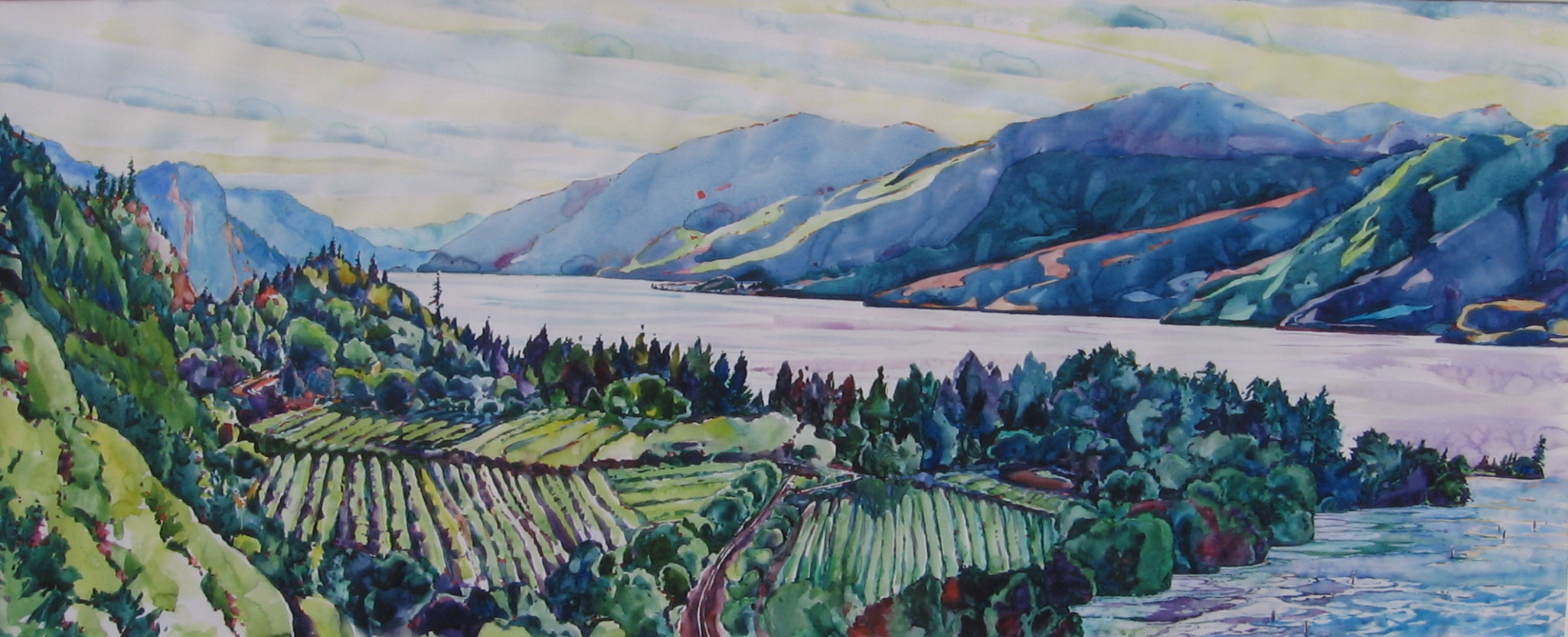 Gary Buhler, Hood River West, Watercolor, 24X64
Gary Buhler, Hood River West, Watercolor, 24X64
Field Guide
The ritual of the farm is easy:
when my grandfather goes,
the land goes too.
What have you taken for granted?
Alfalfa, tamarack,
tin water pinging off the barn roof,
red kites flying in the pasture at dusk.
A bean-shaped lake
filled with stories about Norwegians
who cleared the land (and the Ojibwe
who left it behind).
In the old homestead,
the Norwegian children
practiced writing Our Fathers
on the attic walls. Prayers
we uncover decades later,
hidden under scrap paneling:
a quiet trail of thee’s
and thy’s
wandering around the room.
When my family
burns the empty homestead,
their charcoal prayers go too.
___________
Jolene Brink
Review by Ed Wickliffe
Field Guide is the kind of poem which Ted Kooser, former Poet Laureate and syndicated poetry columnist, might like. The poem is simple and direct, or “accessible” in the common parlance of critique. In fact the poem is so accessible that I tinkered with the notion that it is really just a prose paragraph pretending, as prose often does, to be a columnar poem. That would be a wrong conclusion in this case, however.
The poem is not a prose paragraph in disguise. There is a loose rhythm of mostly twos and threes to the lines with an excellent, though probably unintended, four count line containing “red kites flying in the pasture at dusk.” This extension of the line to an extra beat at that point brings to mind the running out of the kite strings, long and loose like that particular line. This is one example of how form and content can become one in a poem—adding to the reader’s sense of meaning.
The theme of Field Guide, as I see it, is loss—a passing of the era not only for this family farm, but for an entire way of life with its associated values and culture. The family farm of this poem will be gone and its way of life forgotten, much like the Ojibwe Indians who occupied the land before them. The author offers us no hope for the future, no mention of what is to succeed the farmer (corporate farms, quarry mining, tract houses, whatever). Even the family’s scribbled scripture and prayers on scrap panels become ashes in the end. Faith is unrewarded here, prayers are probably unanswered. Everything goes up in smoke both literally and figuratively.
This is not to say the poem is depressing. It is merely the truth about family farms, as anyone outside the big city should know. According to the EPA (environment), only one percent of the U.S. population claims farming as an occupation. According to the BLS (labor) sixty percent of farmers are over 55 years of age. The traditional farmstead is disappearing. For more see: http://www.epa.gov/oecaagct/ag101/demographics.html
This poem, seemingly easy to overlook on first read, becomes much deeper upon re-reading. Fans of Ted Kooser, himself a Midwesterner from farm country, should love this poem. Also anyone who enjoys accessibility in a poem.
Review by Steve Parker
‘Field Guide’ quickly took on another meaning for me as I read, as I started to sense the levels of spirit arcing down into the past and present. Fields. There are overlapping and shifting fields here, of energy and emotion, of acceptance and pain. There are loss and regret, and some deep yearning for the past. The ritual may be easy, but it feels painful and final. Something was taken for granted: ownership, perhaps, or tenure. But something more too: some kind of genius loci that overarches the poem and its history, and isn’t altogether benign.
There is or has been an idyll here, with its pinging rainwater and its red kites above. But that chapter is ending, and there are only tiny hints of whatever future is to come, is already being created. The family will burn the homestead. That suggests a cremation of something, a pagan funerary ritual, a rite of passage from the past to the future. It suggests a readiness to move on, to leave things behind, but why is it necessary to burn the homestead? One senses some exorcism of the old, of memory. Are there dark memories and woundings in this haunted homestead? Why is the exorcism necessary? There are hints at the periphery, and it’s difficult to read how intended they are.
I started to read the edges to see where they took me, and sure enough they took me to darker places. The prayers of children are uncovered in the walls. Archaic language forms echo silently about the attics. What were these lost children praying for? Under all of it the deeper, more lost, more haunted history of the displaced earlier peoples, the Ojibwe: layers of hauntings; ghost fields overlapping. Perhaps inevitably, the ghosts and the red kites and the barn evoked the ’red barn murder’ in my mind, but not specifically: more as an ethereal conjuring of that and all its literary and filmic successors. One can’t see clearly in these misty fields, and one clutches one’s way along the periphery. The Norwegian migrants who cleared the land took me to the travails of the pioneers, and then to the Donner Party – as I said, I was reading the edges, but these things appeared to me and tinged through the poem with its sadness, its exorcism. Something had made that exorcism necessary, and perhaps part of that something can be discerned in the faint, perhaps illegitimate, tropes flickering in the twilight edges of this poem.
By the end, I couldn’t help feeling that there would be relief mingled with regret when someone finally burnt that homestead with its lurking dead prayers. So ultimately this is a poem about escaping from the past, about moving on. Most of us have an old homestead full of ghosts in dire need of burning. This poem is a personal field guide to that.
